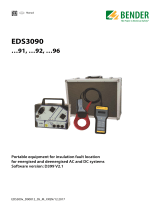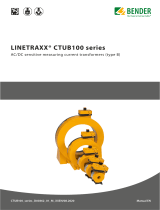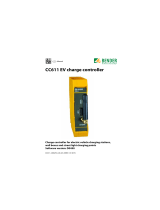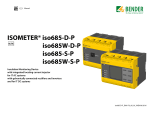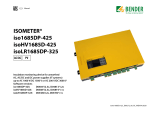
Manual ENCC612(4G)_D00325_06_M_XXEN/09.2021
CC612 charge controller
Charge controller for electric vehicle charging stations, wallboxes or
street light charging points

2 CC612(4G)_D00325_06_M_XXEN/09.2021
Service and support for Bender products
First-level support
Technical support
Carl-Benz-Strasse 8 • 35305 Grünberg • Germany
Telephone: +49 6401 807-760
0700BenderHelp *
Fax: +49 6401 807-629
E-mail: support@bender-service.de
Available on 365 days from 7.00 a.m. to 8.00 p.m. (MEZ/UTC +1)
* Landline German Telekom: Mon-Fri from 9.00 a.m. to 6 p.m.: 6.3 cents/30 sec.; remaining time: 6.3
cents/min.
Mobile phone: higher, depending on mobile phone tari
Repair service
Repair, calibration and replacement service
Londorfer Strasse 65 • 35305 Grünberg • Germany
Telephone: +49 6401 807-780 (technical issues) or
+49 6401 807-784, -785 (commercial issues)
Fax: +49 6401 807-789
E-mail: [email protected]
Field service
On-site service
Telephone: +49 6401 807-752, -762 (technical issues) or
+49 6401 807-753 (commercial issues)
Fax: +49 6401 807-759
E-mail: eldservice@bender-service.de
Mon-Thu 7.00 a.m. to 4.00 p.m., Fri 7.00 a.m. to 1 p.m. (MEZ/UTC +1)

CC612(4G)_D00325_06_M_XXEN/09.2021 3
CC612 charge controller
Table of content
1 General instructions .........................................................................5
1.1 How to use this manual ..............................................................................................5
1.2 Indication of important instructions and information ...................................5
1.2.1 Signs and symbols ........................................................................................................5
1.3 Training courses and seminars.................................................................................5
1.4 Delivery conditions .......................................................................................................5
1.5 Inspection, transport and storage ..........................................................................6
1.6 Warranty and liability...................................................................................................6
1.7 Disposal of Bender devices ........................................................................................6
1.8 Safety .................................................................................................................................6
2 Function ...............................................................................................7
2.1 Intended use ...................................................................................................................7
2.2 Product features (depending on the variant) .....................................................7
2.3 Product description ......................................................................................................8
2.4 Functional description ................................................................................................8
2.4.1 General functions ..........................................................................................................8
3 Dimensions and mounting ........................................................... 10
3.1 Dimensions ...................................................................................................................10
3.2 Mounting .......................................................................................................................10
3.2.1 Charging system with Type 2 socket ..................................................................10
3.2.2 Charging system with a type 2 socket and an intermediate relay .......... 13
4 Connection ....................................................................................... 16
4.1 Connection conditions .............................................................................................16
4.2 Connectivity ................................................................................................................. 17
4.2.1 Master/slave connection ......................................................................................... 18
4.2.1.1 Micro-USB configuration interface (CONFIG) .............................................................. 19
4.2.1.2 Type A USB interface for Ethernet/WLAN adapter .................................................... 19
4.2.1.3 Front panel LEDs (ALARM, READY, PLC)........................................................................19
4.2.1.4 12 V power supply.................................................................................................................19
4.2.1.5 Contactor connection ..........................................................................................................19
4.2.1.6 Control Pilot (CP) and Proximity Pilot (PP) connections .........................................20
4.2.1.7 I/O extension ...........................................................................................................................20
4.2.1.8 Residual direct current monitoring module (RDC-M) .............................................. 20
4.2.1.9 Plug lock connection ............................................................................................................20
4.2.1.10 Connection to lock release modules .............................................................................. 21
4.2.1.11 Connectivity to eHZ or Modbus meters and (optionally) meters with an S0 interface 24
4.2.1.12 Connection with display and authorization modules .............................................24
4.2.2 Master device features ............................................................................................ 24
4.2.2.1 SIM card and SIM card slot ................................................................................................. 25
4.2.3 Antenna socket ........................................................................................................... 25

4 CC612(4G)_D00325_06_M_XXEN/09.2021
5 Configuration and testing ............................................................. 26
5.1 Configuration ...............................................................................................................26
5.1.1 Local configuration of parameters ......................................................................26
5.1.1.1 Periodicle reboot of the charge controller .................................................................27
5.1.2 Remote configuration of parameters ................................................................. 28
5.1.3 Factory settings ...........................................................................................................28
5.1.4 Testing ............................................................................................................................28
5.1.5 Successful boot-up .................................................................................................... 28
5.1.6 Connectivity to the backend .................................................................................28
5.1.6.1 Connection of the charge controller to the backend ..............................................28
5.1.6.2 via GSM (4G modem) ...........................................................................................................29
5.1.6.3 via USB-Ethernet-Adapter oder USB-WLAN (USB 1) ................................................. 29
5.1.7 eHZ/Modbus/S0 meter connectivity ..................................................................30
5.1.8 Plug locking and unlocking ....................................................................................30
5.1.9 Authorisation and charging ................................................................................... 30
6 Connecting to the charge controller ........................................... 31
6.1 Establishing a network connection to the charge controller .................... 31
6.1.1 USB configuration interface ................................................................................... 31
7 Technical data .................................................................................. 32
7.1 Tabular data .................................................................................................................32
7.2 Standards, approvals, certifications ....................................................................34
7.3 Declaration of conformity .......................................................................................35
7.4 Ordering details .......................................................................................................... 36
7.5 Document revision history .....................................................................................37

CC612(4G)_D00325_06_M_XXEN/09.2021 5
CC612 charge controller
1 General instructions
1.1 How to use this manual
This manual is intended for qualified personnel working in electrical engineering and electronics!
Part of the device documentation, in addition to this manual, is the enclosed
"Safety instructions for Bender products".
Read the manual before mounting, connecting and commissioning the device.
Always keep the manual within easy reach for future reference.
1.2 Indication of important instructions and information
I Danger! Indicates a high risk of danger that will result in death or serious injury if not avoided.
I Warning! Indicates a medium risk of danger that can lead to death or serious injury if not avoided.
I Caution! Indicates a low-level risk that can result in minor or moderate injury or damage to property if
not avoided.
i
Information can help to optimise the use of the product.
1.2.1 Signs and symbols
Disposal Temperature range Protect from dust
Protect from mois-
ture
Recycling RoHS directives
1.3 Training courses and seminars
www.bender.de > Know-how-> Seminars.
1.4 Delivery conditions
The conditions of sale and delivery set out by Bender apply. These can be obtained from Bender in printed or
electronic format.
The following applies to software products:
"Softwareklausel zur Überlassung von Standard- Software als Teil von Lieferungen,
Ergänzung und Änderung der Allgemeinen Lieferbedingungen für Erzeugnisse und
Leistungen der Elektroindustrie" (software clause in respect of the licensing of standard soft-
ware as part of deliveries, modifications and changes to general delivery conditions
for products and services in the electrical industry)
Die Elektroindustrie

6 CC612(4G)_D00325_06_M_XXEN/09.2021
General instructions
1.5 Inspection, transport and storage
Check the shipping and device packaging for transport damage and scope of delivery. The following must be
observed when storing the devices:
1.6 Warranty and liability
Warranty and liability claims in the event of injury to persons or damage to property are excluded in case of:
Improper use of the device.
• Incorrect mounting, commissioning, operation and maintenance of the device.
• Failure to observe the instructions in this operating manual regarding transport, commissioning,
operation and maintenance of the device.
• Unauthorised changes to the device made by parties other than the manufacturer.
• Non-observance of technical data.
• Repairs carried out incorrectly.
• Use of accessories and spare parts not recommended by Bender.
• Catastrophes caused by external influences and force majeure.
• Mounting and installation with device combinations not recommended by the manufacturer.
This operating manual and the enclosed safety instructions must be observed by all persons working with the
device. Furthermore, the rules and regulations that apply for accident prevention at the place of use must be
observed.
1.7 Disposal of Bender devices
Abide by the national regulations and laws governing the disposal of this device.
For more information on the disposal of Bender devices, refer to
www.bender.de -> Service & support.
1.8 Safety
If the device is used outside the Federal Republic of Germany, the applicable local standards and regulations
must be complied with. In Europe, the European standard EN 50110 applies.
I Danger! Risk of electrocution due to electric shock! Touching live parts of the system carries the risk of:
• A fatal electric shock
• Damage to the electrical installation
• Destruction of the device
Before installing and connecting the device, make sure that the installation has been de-energised. The rules
for working on electrical systems must be observed.

CC612(4G)_D00325_06_M_XXEN/09.2021 7
CC612 charge controller
2 Function
2.1 Intended use
The CC612 charge controller, hereafter referred to as the charge controller, is the main component of a charg-
ing system and is designed for use in electric vehicle (EV) charging stations, wall boxes and street light charg-
ing points. The charge controller controls type 1 and type 2 plugs, and type 1 and type 2 sockets.It enables a
setup that complies with the requirements of current standards, e.g. IEC 61851-1 and IEC 62955.
Any use other than that described in this manual is regarded as improper.
2.2 Product features (depending on the variant)
• Charge controller in accordance with IEC 61851-1 (mode 3 charging)
• Master and slave operation configurable
• Can be integrated in single- or three-phase systems up to 80 A
• Smart Grid enabled using standard OCPP functionality
• OCPP 1.5 and OCPP 1.6 compliant with JSON, SOAP and Binary implementation
• Supported mobile networks: 4G (LTE), 3G (UMTS) and 2G (GSM) with an integrated 4G modem
• 2 USB interfaces:
– 1 CONFIG for local configuration
– Extension port for peripheral USB devices (Ethernet/WiFi home applications)
• Master/slave hardware configuration
• Control Pilot and Proximity Pilot signal management
• Universal charge plug control (support for different vendors of sockets)
• Configurable support for one additional household socket
• Can connect to eHZ or Modbus meters and to meters with an S0 interface
• User interface board for customer-specific applications
• Configurable 3-channel input/output extension interface for additional functionality
• Only an external RCD type A is required
• Continuous monitoring of AC and DC fault currents using the patented DC fault current monitoring
module
• Internal temperature sensors
• Dynamic load management to optimally distribute the available power among all charging points
and signal the maximum power to the vehicle
• ISO/IEC 15118 power line communication (PLC) for plug & charge and load management systems

8 CC612(4G)_D00325_06_M_XXEN/09.2021
Function
• Local and remote configurations
2.3 Product description
The charge controller monitors the internal hardware of charging systems such as the meter, the user inter-
face module or the socket-outlet. It can be operated as an “always-on system” that is always connected to a
mobile network. The master variant supports 4G mobile networks.
Communication with a backend system is possible via the OCPP application protocol. All specified messages
in OCPP are supported as well as some vendor-specific extensions based on the DataTransfer message.
Integration tests with the backend implementations of providers (e.g. has-to-be, Virta and NewMotion) have
been carried out successfully. Refer to “Ordering details” for product variants..
2.4 Functional description
As well as the charge controller, a charging system also consists of a type A RCD, a relay contactor, which is di-
rectly connected to a type 1 or type 2 socket, or to an attached cable with a type 1 or type 2 plug (see „3.2.1
Charging system with Type 2 socket“ on page 10 ).
2.4.1 General functions
• A charging system may also consist of a meter, and if the meter should be read digitally, either a
smart digital meter (EMH eHZ) or a digital Modbus meter is required.
• The charge controller reads the digital eHZ meter readings using a standard optical reader attached
to the charge controller via an RJ10 cable.
• If the Modbus version is used, the Modbus wires are attached directly to the charge controller.
• Alternatively, any meter with an S0 interface can be attached to one of the available inputs.
• A 12 V power supply is needed to operate the charge controller and an RFID module can be used to
facilitate simple user interaction. The RFID module is a separate PCB and is connected to the charge
controller using a standard RJ45 cable.
• Power flow toward the vehicle is controlled by the contactor (using a signal voltage of up to 30 V),
which is itself controlled by the the charge controller via a relay in the charge controller.
• The SIM card slot (available on charge controller Master variants only) is positioned on the charge
controller front panel. The SIM card can have a PIN number which can be configured via an internal
configuration web interface. The APN settings for the card can also be configured via an internal
configuration web interface.
• Also positioned on the front panel are two USB interfaces:
• The interface known as CONFIG is used to configure the charge controller. Optionally, this interface
can also be used to apply software updates.
• The USB Type-A interface allows the connection of peripheral USB devices.
• Only the front panel of data gateways with 4G modem variants features a connection for a 4G an-
tenna.
• For fault current detection in an AC charging system, the charge controller features an integrated
residual direct current monitoring module (RDC-M) which uses an externally connected current
transformer. With the integrated monitoring of the DC fault current, only an RCD type A is required
in the charging system.
• Data exchange between the EV and the charging system is possible via ISO 15118 compliant
Powerline Communication (PLC).

CC612(4G)_D00325_06_M_XXEN/09.2021 9
CC612 charge controller
• If a malfunction occurs, a report is sent to the backend system using the OCPP protocol.
• Data management and control functionality of the charge controller:
– Termination of the charging process after tripping of the residual current device (RCD) due to a
residual current.
– Detection of critical fault currents by the RCM sensor. For the vehicle owner, this can be an early-
warning, provided that the charge controller is connected to an energy management system
and that it supports this function.
– Load current and cooling control (via a temperature sensor)
The charge controller has internal temperature sensors (on the inside of the controller housing)
that allow the temperature in the ambient environment of the charge controller to be estima-
ted. Based on this estimation it is possible to dynamically reduce the charging current or even
suspend charging. This feature can serve to maintain an ambient temperature within the per-
missible range of the components used in a charging system. Two temperature thresholds can
be set on the manufacturer configuration tab and are based on measurements in common hou-
sing scenarios. The first threshold reduces the charging current to the configured value if it is ex-
ceeded. The second threshold will suspend charging.
i
The temperature measurement is an estimation based on temperature sensors positioned on the inside of
the controller housing where the actual temperature is affected by heat generated by the controller itself.
Because the threshold values are based on measurements in common housing scenarios, each charging
system vendor should undertake practical measurement experiments to validate the correctness of these
thresholds and add offsets if necessary.
• Dynamic load management (DLM):
The charge controller comes with a DLM software, which is fully usable independent of a backend
connection. It detects which charging current is applied to which phase and thus avoids the occur-
rence of peak loads and unbalanced loads. Maximum number of charging points in a network: 250.
• Remote:
– Software updates
– Temperature and residual current monitoring
– Remote login allows for remote maintenance options that reduce the number of maintenance
personal deployments per charger
– Load management through Modbus TCP, SMA SEMP, EEBUS, ASKI
I Caution! Risk of damage when pulling out the measuring current
transformer plug! If the measuring current transformer plug is pulled out
using too much force, the enclosure and the internal components may be
damaged. Use needle-nose pliers to unlock the measuring current transfor-
mer plug.

10 CC612(4G)_D00325_06_M_XXEN/09.2021
Dimensions and mounting
3 Dimensions and mounting
3.1 Dimensions
Abb. 3–1 Note: Dimensions in mm acc. to ISO 2768 - m
* Dimensions incl. antenna socket
3.2 Mounting
i
DIN rail mounting
Example view
3.2.1 Charging system with Type 2 socket
99
22,6
113,65
107
2.
Click!
3.
1.

CC612(4G)_D00325_06_M_XXEN/09.2021 11
CC612 charge controller
Wiring diagram
–
+
IN
M
–
+
A
CP
PP
PE
N L1
L2
L3
e
L1
L2
L3
N
PE
PP
CP
PE
L1 N
L3
L2
f
12V 0V 11 14
B
1
2
3
4
5
6
D
C
–
OUT + IN
A
RJ10
F
RJ45
E
CC612
ALARM
READY
PLC
USB 1
SIM
CONFIG
B
A
PP
IN1–
IN2–
21
IN1+
IN2+
CP
24
C
IN2– IN2+
n
IN1– IN1+
m
21 24
j
PP CP
gh
14
11
0V
12V
i
AC
DC
0 V
12 V
b
d
H
V
a
c
bottom front top

12 CC612(4G)_D00325_06_M_XXEN/09.2021
Dimensions and mounting
i
Charge Controller CC612
The SIM card slot and antenna socket are available on Master variants only. Master variants are:
CC612-1M4PR
CC612-2M4PR
CC612-2M4R
Relay
The relay used to control the contactor is rated for 30 V/1 A. An intermediate relay may be required if this
rating is inadequate.
Contactor
The relay contactor can also be connected to a cable with a type 1 or type 2 plug.
Legend
A Connection locking engine dContactor
B Connection socket User Interface eType 2 socket*
C Connection socket fType 2 plug*
D Connection Current Transformer (CT) gConnection Proximity Pilot
E Connection User Interface (RJ45) hConnection Control Pilot
F Connection Modbus/eHZ meter (RJ10) iRelay 1: Control pin contactor
aRCD Type A jOutput relay 2
bVoltage supply DC 12V mOptocoupler input 1
cCurrent Transformer (CT) with plug nOptocoupler input 2
* Mennekes Typ-2-socket
Assignment of the terminals
A1 IN C1 PP
A2 + C2 CP
A3 OUT C3 21
A4 -C4 24
B1 12 V C5 IN1-
B2 0 V C6 IN1+
B3 11 C7 IN2-
B4 14 C8 IN2+

CC612(4G)_D00325_06_M_XXEN/09.2021 13
CC612 charge controller
3.2.2 Charging system with a type 2 socket and an intermediate relay
Wiring diagram
–
+
IN
M
–
+
A
CP
PP
PE
N L1
L2
L3
e
L1
L2
L3
N
PE
k
PP
CP
PE
L1 N
L3
L2
f
PP
IN1–
IN2–
21
IN1+
IN2+
CP
24
C
IN2– IN2+
n
IN1– IN1+
m
21 24
j
PP CP
gh
12V 0V 11 14
B
1
2
3
4
5
6
D
C
–
OUT + IN
A
RJ10
F
RJ45
E
CC612
ALARM
READY
PLC
USB 1
SIM
CONFIG
B
A
14
11
0V
12V
i
AC
DC 0 V
12 V
b
c
d
H
V
a
bottom front top

14 CC612(4G)_D00325_06_M_XXEN/09.2021
Dimensions and mounting
Legend
A Connection locking engine dContactor
B Connection socket User Interface eType 2 socket*
C Connection socket fType 2 plug*
D Connection Current Transformer (CT) gConnection Proximity Pilot
E Connection User Interface (RJ45) hConnection Control Pilot
F Connection Modbus/eHZ meter (RJ10) iRelay 1: Control pin contactor
aRCD Type A jOutput relay 2
bVoltage supply DC 12V kIntermediate relay
cCurrent Transformer (CT) with plug mOptocoupler input 1
nOptocoupler input 2
* Mennekes Typ-2-socket
Assignment of the terminals
A1 IN C1 PP
A2 + C2 CP
A3 OUT C3 21
A4 -C4 24
B1 12 V C5 IN1-
B2 0 V C6 IN1+
B3 11 C7 IN2-
B4 14 C8 IN2+

CC612(4G)_D00325_06_M_XXEN/09.2021 15
CC612 charge controller
Connection Type 2 Socket
Supported Type 2 sockets* - OUT + IN
Socket actuator wiring
• Mennekes (31016, 31023, 31024, 31038)
• Bals (801191-801195, 80300, 9743205000, 9743211000)
• Walther Werke (9743211000)
• Harting
Wire 3 Wire 1 Wire 2
• Walther Werke Eco Slim 32 A (9743205180)
with connection cable (790000001)
Wire 1
(black)
Wire 3
(blue)
Wire 2
(red)
• Phoenix Contact (1405213, 1405214, 1405215, 1405216,
• 1408171, 1408172)
BU/BN BU/GN BU/RD BU/YE
* Each type 2 socket can also be used in conjunction with lock release modules from Mennekes and Phoenix
Contact.
Connection to Type 1/Type 2 plug
L1 L1
L3
NPE
L2/N
L1
CS CP
PE
PP
CP
PE
L1 N
L3
L2
L2
N
PE

16 CC612(4G)_D00325_06_M_XXEN/09.2021
Connection
4 Connection
4.1 Connection conditions
I risk of electric shock! Parts of the system may be live (charge controller terminals up to 12 V, charging sta-
tion 230 V). Before touching parts of the system, ensure that it has been de-energised.
I Caution! Risk of injury from sharp-edged terminals! Handle enclosure and terminals with care.
I the RJ45 user interface is not intended as an Ethernet interface.
i
Information:
• Connect PE to “0V”; reference level for Control Pilot (CP communication) must be at same level as
the power supply (IEC 61851 standard).
• Cable lengths (except Modbus, Power IN and charging cable) < 3 m; cables must be positioned in-
side the wallbox/charging station and should not be laid parallel to power cables.
• Modbus (A, B) must be connected using a shielded cable; connect shield to PE..
i
For further information on connection, refer to the manuals of the accessories (e.g. CTBC17).

CC612(4G)_D00325_06_M_XXEN/09.2021 17
CC612 charge controller
4.2 Connectivity
Charge controller connections for all device variants
A Front view Data gateway (with modem)
B Front view Data gateway (without modem)
C Bottom
DTop Variant with eHz meter
ETop Variant with Modbus meter
2
CC612
ALARM
READY
PLC
USB 1
SIM
CONFIG
3
1
4 4
5
SIM
CC612
ALARM
READY
PLC
USB 1
CONFIG
1
11
12
13
13
A
B
11
6
7
10
IN1- 24
IN1+
9
8
12V 0V 11 14
PP CP
IN2- IN2+
21
AB
CDE

18 CC612(4G)_D00325_06_M_XXEN/09.2021
Connection
Legend
1 USB interface for Ethernet/WLAN/connection to Master
2 SIM card slot
3 Antenna socket
4 Configuration interface/connection to Slave
5 LEDs for:
• ALARM
• READY (Online connectivity)
• PLC (Power Line Communication)
6 12 V power supply
70 V
8 Relay 1 (Control voltage contactor)
9 Relay 1 (Contactor control pin)
10 Connection current transformer
11 Connection to user interface via RJ45 cable
12 Meter connection
13 Plug lock connections
4.2.1 Master/slave connection
The charge controller can function as a data gateway with 4G modem (the dedicated controller is switched
into Master mode) or data gateway without 4G modem. Master/Slave operation can be configured by con-
necting the USB configuration interface of one charge controller (DLM Master) to a USB interface for Ethernet/
WLAN of the second charge controller (DLM Slave) using a USB cable. For each DLM Master/DLM Slave variant,
there are connections common to both (these are described in the following sections) and there are differenc-
es, which are described in „4.2.2 Master device features“ on page 24.
Currently one DLM Slave can connect to the DLM Master. The communication protocol is binary OCPP 1.6.
Essentially the Master controller becomes the OCPP backend for the DLM Slave. The DLM Master exposes each
DLM Slave as an additional connector to the backend.
A charge controller is assigned the Master and Slave role on the Manufacturer tab. Each DLM Slave controller
then needs to be assigned the IP address of of the DLM Master as its binary OCPP hostname and needs to use
port 1600 as the binary OCPP port to connect to the DLM Master. Multiple connectivity technologies to con-
nect DLM Master and DLM Slave can be used, for example Ethernet and, where available, WLAN.
i
The configurations such as IP addresses port etc. are generated automatically.
The Master is assigned an additional IP address of 192.168.125.124 on the Settings tab without assigning a
standard gateway. The Slave uses the IP address 192.168.125.125 to connect to the Master. Using USB as the
connection technology is more cost efficient than using multiple Ethernet cables or WLAN, but limits the dis-
tance of the controllers to a few meters as the maximum length of a USB cable is 5 meters. The DLM Slave
configuration web page (e.g. http://192.168.123.123) then offers links to access the Master and the Slave
configuration.

CC612(4G)_D00325_06_M_XXEN/09.2021 19
CC612 charge controller
4.2.1.1 Micro-USB configuration interface (CONFIG)
The USB configuration interface (CONFIG) on the charge controller front panel is connected to a conventional
laptop, PC or tablet computer with a normal USB host interface via a micro USB cable. This interface allows the
device to be configured locally. In addition, it also enables software updates. Configuration details are outli-
ned in „5.1.1 Local configuration of parameters“ on page 26. In addition, Master/Slave operation can be
configured by connecting the USB configuration interface of one charge controller (DLM Master) to a USB in-
terface for Ethernet/WLAN of the second charge controller (DLM Slave) using a USB cable.
4.2.1.2 Type A USB interface for Ethernet/WLAN adapter
The USB Ethernet/WLAN interface provides a way of connecting the charge controller to an existing Ethernet/
WLAN network. Refer to „5.1.6.3 via USB-Ethernet-Adapter oder USB-WLAN (USB 1)“ on page 29. In addition,
Master/Slave operation can be configured by connecting the USB configuration interface of one charge cont-
roller (DLM Master) to a USB interface for Ethernet/WLAN of the second charge controller (DLM Slave) using a
USB cable.
4.2.1.3 Front panel LEDs (ALARM, READY, PLC)
The LEDs located on the front panel are used to indicate:
• An error has occurred (ALARM)
• Online connectivity to a backend system (READY)
• Powerline Communication (PLC) acc. to ISO 15118
(This LED is not shown on the front panel of variants which do not feature PLC.)
4.2.1.4 12 V power supply
The charge controller is supplied with power from a 12 V main voltage source at the +12V and 0V connec-
tions.
4.2.1.5 Contactor connection
The charge controller controls the contactor that in turn controls the power flow toward the vehicle.
Contactor control is exercised by a relay in the charge controller whose contacts are rated up to 30 V/1 A. The
actual power for the signal circuit has to be looped into the circuit by correct wiring, i.e. one pin of the charge
controller relay 1 (11) has to be connected to the 12 V power supply, the second charge controller relay 1 pin
(14) must be connected to the contactor control pin. The second contactor control pin must be connected to
the other pole (0V) of the power source.
I relay 1 is rated for 30 V/1 A. An intermediate auxiliary relay may be required if this rating is considered in-
adequate.
If an intermediate relay is required, then the second charge controller relay 1 pin (14) must be connected to
the intermediate relay control pin instead of to the contactor control pin. The second intermediate relay cont-
rol pin must be connected to the other pole (0 V) of the power source. The contactor control pin is then con-
nected to the supply voltage (e.g. 230 V) and the other pin is connected to the neutral conductor.

20 CC612(4G)_D00325_06_M_XXEN/09.2021
Connection
4.2.1.6 Control Pilot (CP) and Proximity Pilot (PP) connections
The Control Pilot (CP) and Proximity Pilot (PP) contacts connect the charge controller to the outlet, enabling it
to communicate with the vehicle and the cable plug. The CP and PP contact allow the charge controller to de-
termine whether a cord has been plugged into the socket (proximity) and to inform the vehicle about the
amount of power it can draw (refer to IEC 61851).
i
The CP terminal is used for Power Line Communication (PLC) in charge controller variants with this integ-
rated feature.
4.2.1.7 I/O extension
The CC612 has additional I/O interfaces available via a configurable 3-channel I/O interface (connector C: 21,
24, IN1-, IN1+, IN2-, IN2+) that can be used for multiple purposes, for example:
• Parking management interface (The supported communication protocol is proprietary to Scheidt &
Bachmann and based on the available auxiliary relay and one available input)
• Additional household main socket outlet control
• Power outage monitoring (e.g. RCD trip monitoring)
• Cooling fan switch for over-temperature control
• Connection to a meter with an S0 interfaced.
4.2.1.8 Residual direct current monitoring module (RDC-M)
For fault current detection in an AC charging system, an integrated residual direct current monitoring module
(RDC-M) is used. This module uses an external magnetically shielded measuring current transformer. This all-
ows the use of a residual current device (RCD) type A instead of an RCD type B. The relay in the charge cont-
roller is de-energised if, during the charging process, a fault current IΔn ≥ DC 6 mA flows. The measured fault
currents RMS/DC are made available to the backend system via OCPP message. The use of device variants
with an integrated 4G modem is only possible in member states of the European Union.
i
To ensure electrical safety, the switch-off times according to IEC 62955 are observed.
4.2.1.9 Plug lock connection
Under normal operating conditions, the type 2 socket automatically locks the plug when a vehicle is connec-
ted to the charging system. The locking action can be heard. After disconnecting the plug from the vehicle,
the charging system socket automatically unlocks the charging system socket and the cable can be removed.
If both locking and unlocking work, the socket was correctly attached to the charging system controller. Via
terminals IN , +, OUT, - (i.e. plug lock connections), the charge controller can interface to different socket/ac-
tuator types. Type 2 sockets from various manufacturers and their corresponding connection to the charge
controller are shown in „Connection Type 2 Socket“ on page 15:
Page is loading ...
Page is loading ...
Page is loading ...
Page is loading ...
Page is loading ...
Page is loading ...
Page is loading ...
Page is loading ...
Page is loading ...
Page is loading ...
Page is loading ...
Page is loading ...
Page is loading ...
Page is loading ...
Page is loading ...
Page is loading ...
Page is loading ...
Page is loading ...
Page is loading ...
Page is loading ...
/

